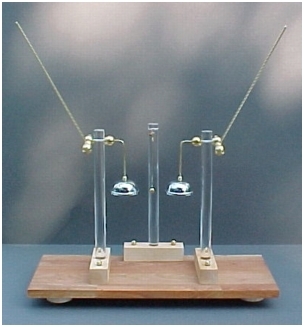|
Franklin’s Bells ( Gordon’s Bells) |
| About Static Machines | About Leyden Jars |
|

Electrostatic bells like these are often referred to as Franklin's Bells, after the eminent American scientist Benjamin Franklin, who installed them in his house to warn him of approaching thunderstorms, as is recorded in a famous portrait of Franklin observing his set of electrostatic bells as a thunderstorm raged outside. This electrostatic device actually was invented in about 1742 by Andrew Gordon, Professor of Natural Philosophy at the University at Erfurt, Germany. Gordon's Bells constituted the first device that converted electrical energy into mechanical energy in the form of continuous mechanical motion, in this case, the moving of a bell clapper back and forth between two oppositely charged bells.
Our model of Gordon's Bells provides a simple yet marvelous demonstration of the Law of Conservation of Energy that can be understood easily by science students of all ages. First, a static generating machine is connected to the instrument so that one of the two bells receives a positive charge and the other receives a negative charge. Suspended between the two bells is a bell clapper, which receives an induced electrostatic charge from one of the bells, to which it is attracted. The clapper swings toward the attracting bell until they touch, the bell chimes, and the clapper takes on the same charge as the bell. Because like charges repel each other, the clapper immediately is electrostatically repelled away from the first bell and, because opposite charges are attracted to each other, the clapper is electrostatically attracted to the opposite bell. When the clapper rings the second bell, the clapper takes on the charge of the second bell, is repelled by it, and then returns to ring the first bell. The process keeps repeating as long as opposite electrostatic charges reside on the two bells.
Collector's Model: $445 plus shipping.
|
|
|
Crystal Radios |
Regenerative Radios |
Radio Kits |
Static Machines |
Induction Coils |
Vacuum Tubes |
Classic Reprints |
Tesla Reprints |
Used & Rare |